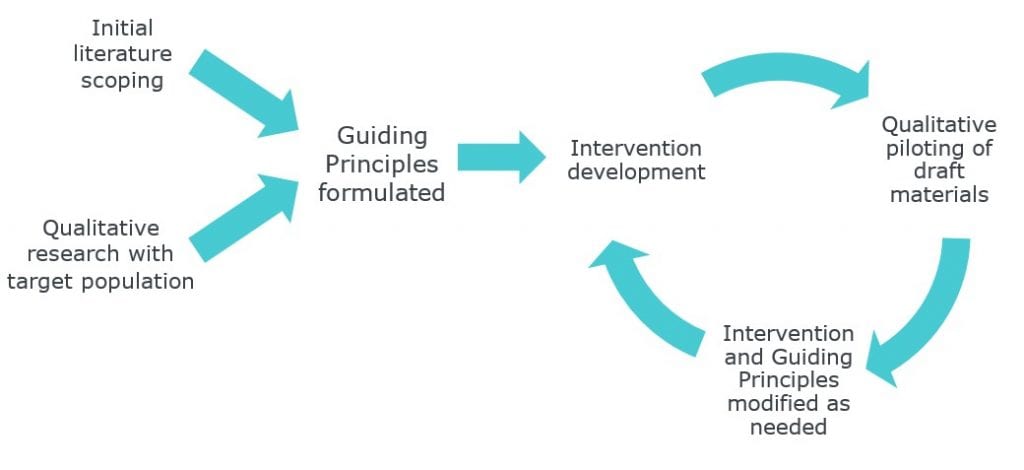The person-based approach to developing interventions: a tried and tested method
By Artur Direito, on 29 November 2017
By Dr. Teresa Corbett, Research Fellow for Psychology at the University of Southampton
Incorporating the perspective of target users is a key part of good intervention development. The LifeGuide team at the University of Southampton, use the “person-based” approach (PBA) to develop successful digital interventions to help people manage their health or illness. The PBA uses in-depth qualitative research to complement existing theory-based and evidence-based approaches to intervention development. There are two key parts of the person-based approach.
- Qualitative research
At every stage of intervention development (from planning to feasibility testing and implementation), we conduct qualitative interviews with a wide range of people from the target user populations. We recruit participants who vary in characteristics that are considered important to the intervention. These interviews help us to get to know the context in which the intervention will be used.
Our aim is to go beyond a traditional focus on acceptability, usability, and satisfaction. By attempting to understand the target users’ attitudes, motivations, needs, and circumstances, we can select intervention components that seem the most acceptable, feasible, and salient to them. Importantly, we can also modify or avoid including elements of an intervention that are disliked or seen as impractical or invasive. Using the PBA enables our team to anticipate barriers and facilitators to intervention use.
Based on this in-depth qualitative research, we iteratively modify the intervention to make it more persuasive, feasible, and relevant to users. The PBA also allows us to better interpret intervention usage and outcomes.
- Guiding Principles
Once we have identified important context-specific behavioural issues, we put together “guiding principles” that inform the intervention development. “Guiding principles” are distinctive features of the intervention that are key to achieving the aims of the intervention. In developing these guiding principles, we:
- Outline the aim of the intervention in terms of behaviour change and outcomes.
- Describe important characteristics of the target users of the intervention, including their psychosocial characteristics and the behavioural context in which they will use the intervention.
- Highlight behavioural issues, needs, or challenges the intervention must address.
- Identify key intervention design objectives (based on challenges and needs identified as crucial to intervention success).
- Identify key features of the intervention that can achieve those objectives. In doing so, we develop hypotheses about the characteristics of the intervention that should enhance its acceptability, feasibility, and therefore effectiveness.

An example of using the PBA
We have been working on a programme to improve the quality of life for people after cancer. We used the PBA to learn more about the wellbeing-related needs and behaviour change priorities of those who have completed treatment for cancer.
We reviewed a variety of study designs (e.g. quantitative/qualitative research, feasibility/pilot trials) to help us to identify features of web-based interventions that may improve outcomes in cancer survivors. These findings were used to develop a set of Guiding Principles that informed initial intervention development.
Once we had developed a prototype intervention, the content was refined based on feedback from think-aloud interviews. Then we asked people to try out using the intervention on their own and later, we interviewed them about their experiences to find out more about how they perceive and use the intervention at home. In total, we conducted 116 in-depth qualitative interviews with 66 cancer survivors to elicit perceptions of the intervention. We used this qualitative data to inform iterative changes to the intervention.
Using the PBA helped us to find out more about what features of web-based interventions might be important for cancer survivors. We were able to identify potential barriers and facilitators to engaging with the intervention. We also learned more about individual variation in understanding, motivation, and perceived need to change certain behaviours.
Conclusions
The PBA is a tried and tested method based on thousands of in-depth interviews. The team has created and evaluated a variety of health-related interventions, including public health interventions (eg, to manage weight and stress, promote physical activity and hand hygiene) and illness management interventions (to help users cope with dizziness, back pain, fatigue, respiratory conditions, hypertension, diabetes, cancer, stroke, and many more health problems). Trials of these interventions have established that what we have learned is effective in practice. The PBA helps us to find out more about the features that are most likely to be important in a particular intervention and how to include them in a manner that is both acceptable and persuasive to users.
Questions:
What do you think of the person-based approach?
How does this method differ from traditional user testing?
What are the pros and cons of using this approach in a research setting?
Bio:

Dr. Teresa Corbett
Dr Teresa Corbett (@Treasa_corbett) is a Research Fellow for Psychology at the University of Southampton. As part of the Centre for Clinical and Community Applications of Health Psychology (CCCAHP) team, she develops and evaluates online interventions for managing health conditions and other medical issues. Teresa’s research to date has focused on the development of acceptable and engaging interventions for post-treatment cancer survivors.
Key Papers
Yardley, L., Morrison, L., Bradbury, K., & Muller, I. (2015). The person-based approach to intervention development: application to digital health-related behavior change interventions. Journal of medical Internet research, 17(1), e30.
Yardley, L., Ainsworth, B., Arden-Close, E., & Muller, I. (2015). The person-based approach to enhancing the acceptability and feasibility of interventions. Pilot and Feasibility Studies, 1(1), 37.
Band, R., Bradbury, K., Morton, K., May, C., Michie, S., Mair, F. S., Murray, E., McManus R. J., Little, P. & Yardley, L. (2017). Intervention planning for a digital intervention for self-management of hypertension: a theory-, evidence-and person-based approach. Implementation Science, 12(1), 25.
Corbett T, Singh K, Payne L, et al. Understanding acceptability of and engagement with web-based interventions aiming to improve quality of life in cancer survivors- a synthesis of current research. Psycho-Oncology. 2017. https://doi.org/10.1002/pon.4566
 Close
Close


